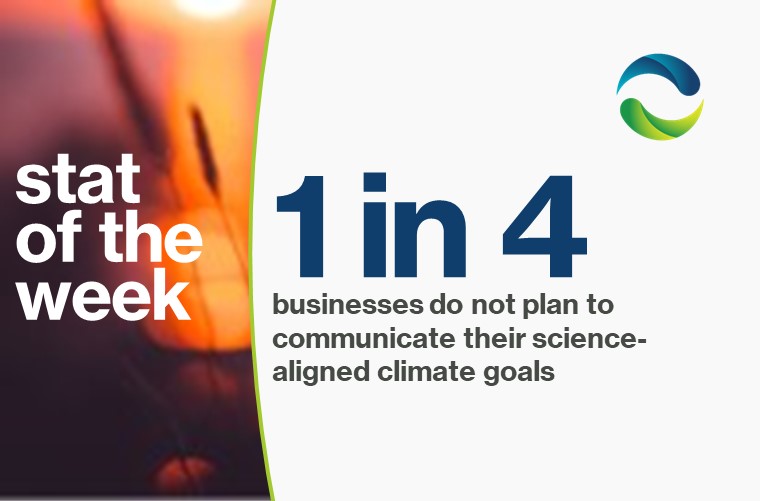Today – April 22, 2022 – marks the 52nd anniversary of Earth Day, a day to celebrate the planet and promote environmental protection. The theme of Earth Day 2022, “Invest in Our Planet,” highlights the need for businesses, governments, and citizens to “act boldly, innovate broadly, and implement equitably.” Notably, it calls for a partnership to alter the business climate.
So, what can companies do to act on climate? We present eight steps that businesses can implement in order to set and advance their climate goals. These actions not only help protect our planet’s health, but also, they create opportunities for business growth through operational efficiency, reduced costs, and reputation enhancement.
-
Set a science-based target. Science-based targets (SBTs) have become the standard for measuring and reducing emissions to limit global warming to 1.5 degrees Celsius. Typically, two tiers of targets are set – short-term targets to decrease emissions by a given percentage (e.g., 30% reduction of Scope 1 and 2 emissions by 2030) and a longer-term target to reach net-zero emissions, often by 2050. Setting both goals can help ensure that progress is made immediately to meet the first goal, with sustained efforts to lower all emissions to zero by the middle of the century. Joining the ranks of organizations with SBTi-verified (Science Based Target Initiative) goals can be a decisive first step toward leading a climate-friendly business that is better insulated from future risks.
-
Select suppliers who have made commitments to reduce carbon emissions. The reduction of scope 3 emissions – indirect emissions within the value chain not controlled by the reporting organization – is an essential ingredient to lowering a company’s overall carbon impact. Scope 3 often makes up the majority of a sector’s footprint; for instance, of infrastructure companies with SBT commitments, scope 3 constitutes 89% of total emissions. As such, engaging with suppliers who are committed to climate action is key to meeting emissions reductions targets.
-
Leverage the roles of financial leaders. Financial leaders, particularly the CFO, play a key role in a company’s climate success. The CFO role is evolving into a sustainability role, as climate is recognized as financial risk. Financial teams can help direct resources to drive emissions reduction efforts, improve risk monitoring, invest in energy-efficient technology, and more. The involvement of financial leaders in the climate space yields numerous benefits, including enhanced environmental performance, investor base diversification, and reduced physical risk.
-
Incorporate sustainability across the companies. As C-suites begin hiring Chief Sustainability Officers and building teams of ESG experts, business leaders must also ensure that this knowledge and motivation doesn’t remain siloed within ESG or sustainability divisions. Embedding climate champions across functional areas, convening sustainability steering committees of leaders with distinct responsibilities, and introducing ESG key performance indicators (KPIs) can work to engage the entire organization in action. Progress will only accelerate when business areas and individuals at all levels of the organization are working toward, not against, sustainability and emissions-reduction goals.
-
Engage with local communities. Supporting local communities can reduce a business’s carbon footprint. By sourcing locally, companies reduce the emissions associated with the transportation of goods. Buying locally may also help reduce waste – particularly food waste – as products are less likely to damage across the supply chain. In addition to emissions reduction benefits, engaging with local communities supports the local workforce, land, and wildlife, while cutting down on transportation and material costs.
-
Push for broader public sector action. While operational and strategic tactics for sustainability will have the most immediate impacts, companies can also leverage their influence and voice to promote action by governments and utilities. Scope 2 emissions profiles hinge on the origin of electricity that a company uses and engaging with the industry and utilities to accelerate use of renewable energy sources. For companies that lack the scope to develop or directly purchase solar and wind energy from farms, leaders can still call on utility companies and the public sector to move away from coal, oil, and natural gas. Companies can also make statements in favor of regulatory and policy changes (e.g., the SEC climate disclosure mandates) that encourage more transparent and environmentally-responsible business practices.
-
Build workplace culture around sustainability. Beyond comprehensive emissions reduction targets, smaller-scale shifts toward sustainability can also contribute meaningfully to a more sustainable company. Factoring environmental responsibility into procurement, office management, and culture decisions can raise the day-to-day visibility of an organization’s commitment to sustainability. Younger employees are increasingly motivated to work at companies that prioritize the environment. Steps to lower waste, increase recycling rates, incentivize lower-impact commuting, etc. will foster a more environmentally conscious workplace and have positive spillovers into the business.
-
Become a member of The Climate Board! As our most recent Stat of the Week post points out, most business leaders know that they need help if they’re going to make more progress on their sustainability goals. The Climate Board exists to help those leaders accelerate their efforts. We’re proud to help companies identify and implement practical steps that support climate goals while building important connections within and across industries. To learn more about our work and how our distinctive membership model could support your climate strategy, contact us at info@theclimateboard.com.



